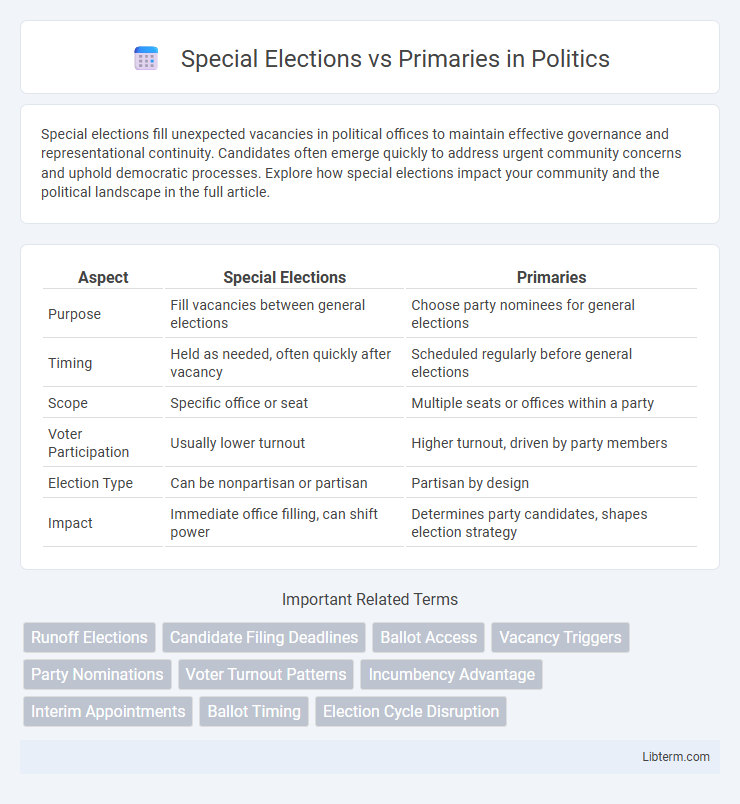Special elections fill unexpected vacancies in political offices to maintain effective governance and representational continuity. Candidates often emerge quickly to address urgent community concerns and uphold democratic processes. Explore how special elections impact your community and the political landscape in the full article.
Table of Comparison
| Aspect | Special Elections | Primaries |
|---|---|---|
| Purpose | Fill vacancies between general elections | Choose party nominees for general elections |
| Timing | Held as needed, often quickly after vacancy | Scheduled regularly before general elections |
| Scope | Specific office or seat | Multiple seats or offices within a party |
| Voter Participation | Usually lower turnout | Higher turnout, driven by party members |
| Election Type | Can be nonpartisan or partisan | Partisan by design |
| Impact | Immediate office filling, can shift power | Determines party candidates, shapes election strategy |
Understanding Special Elections and Primaries
Special elections are held to fill vacancies that occur when an officeholder resigns, passes away, or is otherwise unable to serve, often occurring outside the regular election schedule. Primaries are preliminary elections where political parties select their candidates for an upcoming general election, and they typically occur on a fixed schedule. Understanding the timing, purpose, and voter eligibility differences between special elections and primaries is crucial for comprehending the electoral process and its impact on political representation.
Key Differences Between Special Elections and Primaries
Special elections fill vacancies that occur between regular election cycles, while primaries determine party nominees for upcoming general elections. Special elections often have accelerated timelines and lower voter turnout compared to primaries, which follow established schedules and engage broader party participation. Candidates in special elections may face unique filing requirements and campaign dynamics distinct from the structured process of primary elections.
Purpose and Significance of Special Elections
Special elections are held to fill vacancies in public office that occur between regular election cycles, ensuring continuous representation and maintaining government functionality. Unlike primaries, which determine party candidates for upcoming general elections, special elections address immediate electoral gaps caused by resignations, deaths, or removals. These elections hold significant impact by potentially altering legislative balances and addressing urgent local or national governance needs outside scheduled voting dates.
Purpose and Significance of Primaries
Primaries serve as the essential mechanism for political parties to select their candidates for general elections, ensuring voter participation in the candidate nomination process. They allow party members and independent voters to influence the political landscape by choosing representatives who best align with their values and policy preferences. This democratic selection process enhances electoral legitimacy and prepares candidates for the broader contests in general elections.
How Special Elections Are Triggered
Special elections are triggered when a public office becomes vacant before the scheduled end of the term due to reasons such as resignation, death, or removal from office. These elections are held to fill the seat quickly and maintain representation, differing from primaries that determine party candidates for regularly scheduled general elections. Special election dates are often set by state governors or legislatures according to state-specific laws and regulations.
Primary Election Types: Open vs Closed
Primary elections determine party nominees, with open and closed primaries as common types. In an open primary, any registered voter can participate regardless of party affiliation, promoting broader voter engagement. Closed primaries restrict voting to registered party members, ensuring candidates reflect the party's core supporters.
Voter Participation in Special Elections vs Primaries
Special elections typically see significantly lower voter participation compared to primaries, often due to less public awareness and shorter campaign periods. Primaries benefit from established party mobilization efforts and occur during regular election cycles, attracting higher turnout. Lower engagement in special elections can impact representation and election outcomes, emphasizing the need for enhanced voter education and outreach strategies.
Impact on Political Parties and Candidates
Special elections often disrupt the usual nomination process, providing opportunities for lesser-known candidates to gain visibility and challenge established party figures. Primaries serve as structured contests within political parties, allowing candidates to build organized support and resources over time. The unpredictable timing and lower turnout of special elections can shift party dynamics by favoring more energized voter bases and altering candidate viability.
Election Outcomes and Representation
Special elections often yield lower voter turnout compared to primaries, leading to election outcomes that may not fully represent the broader electorate's preferences. Primaries generally engage more party-affiliated voters, influencing candidate selection and ensuring stronger alignment with party ideologies. This distinction impacts representation by affecting the diversity and legitimacy of elected officials, with primaries typically producing candidates who reflect established party bases more accurately than the often unpredictable results of special elections.
Recent Trends and Examples in U.S. Special Elections and Primaries
Recent trends in U.S. special elections and primaries reveal increasing voter engagement driven by heightened political polarization and critical local issues, exemplified by the 2021 Georgia Senate runoff and the 2023 California gubernatorial recall primary. Special elections often experience lower turnout but can serve as key indicators for party momentum, as seen in the 2022 Texas congressional special elections where Republicans solidified gains. Primaries have become battlegrounds for ideological shifts within parties, with the 2024 Democratic and Republican primaries highlighting the influence of grassroots mobilization and digital campaigning on candidate success.
Special Elections Infographic

 libterm.com
libterm.com